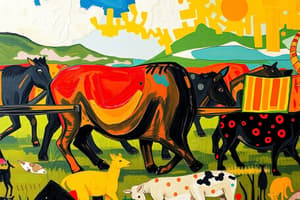Podcast
Questions and Answers
What type of species are the first to grow back after a fire in a forest ecosystem?
What type of species are the first to grow back after a fire in a forest ecosystem?
- Climax community species
- Pioneer species (correct)
- Shrubs
- Intermediate species
What does the climax community represent in an ecosystem?
What does the climax community represent in an ecosystem?
- A state of perpetual growth with no changes
- The final successional stage that resembles the pre-disturbance community (correct)
- A community primarily consisting of pioneer species
- An equilibrium state that remains unchanged
Which type of species emerge after pioneer species during the successional process?
Which type of species emerge after pioneer species during the successional process?
- Intermediate species (correct)
- Annual species
- Climax community species
- Primary species
What role do shrubs and small trees play in the successional process after a forest fire?
What role do shrubs and small trees play in the successional process after a forest fire?
What is the nature of the equilibrium state in a climax community?
What is the nature of the equilibrium state in a climax community?
What type of distribution is commonly exhibited by plants that drop seeds directly to the ground?
What type of distribution is commonly exhibited by plants that drop seeds directly to the ground?
Which distribution pattern is likely to be observed in animals that form social groups?
Which distribution pattern is likely to be observed in animals that form social groups?
What is a characteristic of uniform distribution in plants?
What is a characteristic of uniform distribution in plants?
What role does demography play in the study of populations?
What role does demography play in the study of populations?
Which of the following best describes the information provided by life tables?
Which of the following best describes the information provided by life tables?
In which scenario would individuals in a population experience difficulty finding mates due to their distribution?
In which scenario would individuals in a population experience difficulty finding mates due to their distribution?
What is an example of uniform distribution in animals?
What is an example of uniform distribution in animals?
What can be inferred about the distribution of species with a low density?
What can be inferred about the distribution of species with a low density?
What is a quadrat primarily used for in ecological studies?
What is a quadrat primarily used for in ecological studies?
What feature of age structure diagrams indicates rapid population growth?
What feature of age structure diagrams indicates rapid population growth?
Which method is commonly used for estimating populations of smaller mobile organisms like mammals?
Which method is commonly used for estimating populations of smaller mobile organisms like mammals?
What does species richness refer to?
What does species richness refer to?
What does the mark and recapture method rely on to estimate population size?
What does the mark and recapture method rely on to estimate population size?
How do the age structures of developed countries differ from those of underdeveloped countries?
How do the age structures of developed countries differ from those of underdeveloped countries?
Which factor is NOT mentioned as influencing species richness?
Which factor is NOT mentioned as influencing species richness?
Which stage of population growth is most commonly associated with zero population growth?
Which stage of population growth is most commonly associated with zero population growth?
What assumption is made when using the mark and recapture method?
What assumption is made when using the mark and recapture method?
Which regions are likely to exhibit the highest population growth rates?
Which regions are likely to exhibit the highest population growth rates?
Foundation species are known for which of the following roles in a community?
Foundation species are known for which of the following roles in a community?
Which of the following is NOT a type of species distribution pattern?
Which of the following is NOT a type of species distribution pattern?
What does a stable population diagram resemble in terms of shape?
What does a stable population diagram resemble in terms of shape?
Which of the following is an example of a foundation species?
Which of the following is an example of a foundation species?
What is one characteristic of random distribution in species?
What is one characteristic of random distribution in species?
What distinguishes a keystone species?
What distinguishes a keystone species?
What was one prediction made regarding human population growth?
What was one prediction made regarding human population growth?
What impact does species distribution pattern have on estimating population sizes?
What impact does species distribution pattern have on estimating population sizes?
If 80 field mice are captured, marked, and released, followed by capturing 100 mice with 20 marked, what is the estimated population size using the equation?
If 80 field mice are captured, marked, and released, followed by capturing 100 mice with 20 marked, what is the estimated population size using the equation?
Which of the following statements about species richness is accurate?
Which of the following statements about species richness is accurate?
In age structure diagrams, what does a narrowing shape towards the top signify?
In age structure diagrams, what does a narrowing shape towards the top signify?
In what way do foundation species typically influence their environment?
In what way do foundation species typically influence their environment?
Which economic condition is most likely associated with a pyramidal age structure?
Which economic condition is most likely associated with a pyramidal age structure?
When discussing island biogeography, which relationship is emphasized?
When discussing island biogeography, which relationship is emphasized?
What is required for warning coloration to be effective against predators?
What is required for warning coloration to be effective against predators?
What role does mimicry play in the survival of harmless species?
What role does mimicry play in the survival of harmless species?
Why do multiple species sharing the same warning coloration enhance predator avoidance?
Why do multiple species sharing the same warning coloration enhance predator avoidance?
Which of the following is an example of mimicry mentioned in the content?
Which of the following is an example of mimicry mentioned in the content?
What is the purpose of warning coloration for species like the fire-bellied toad?
What is the purpose of warning coloration for species like the fire-bellied toad?
In the context of predator behavior, what must happen for a naïve predator to learn to avoid certain prey?
In the context of predator behavior, what must happen for a naïve predator to learn to avoid certain prey?
Which factor is NOT a part of a species' ecological niche?
Which factor is NOT a part of a species' ecological niche?
What, according to ecological principles, is a major factor that limits resources in a habitat?
What, according to ecological principles, is a major factor that limits resources in a habitat?
Flashcards
Clumped distribution
Clumped distribution
A pattern of population distribution where individuals are grouped together in patches.
Uniform distribution
Uniform distribution
A pattern of population distribution where individuals are spaced evenly apart.
Random distribution
Random distribution
A pattern of population distribution where individuals are scattered randomly in space.
Population demography
Population demography
Signup and view all the flashcards
Life table
Life table
Signup and view all the flashcards
Mortality rate
Mortality rate
Signup and view all the flashcards
Life expectancy
Life expectancy
Signup and view all the flashcards
Population density
Population density
Signup and view all the flashcards
Quadrat method
Quadrat method
Signup and view all the flashcards
Mark and recapture
Mark and recapture
Signup and view all the flashcards
Population size calculation
Population size calculation
Signup and view all the flashcards
Species Distribution Patterns
Species Distribution Patterns
Signup and view all the flashcards
Population Growth Prediction
Population Growth Prediction
Signup and view all the flashcards
Rapid Growth Age Structure
Rapid Growth Age Structure
Signup and view all the flashcards
Slow Growth Age Structure
Slow Growth Age Structure
Signup and view all the flashcards
Zero Population Growth Age Structure
Zero Population Growth Age Structure
Signup and view all the flashcards
Population Growth Rates
Population Growth Rates
Signup and view all the flashcards
Age Structure Diagrams
Age Structure Diagrams
Signup and view all the flashcards
Population Explosion
Population Explosion
Signup and view all the flashcards
The Population Bomb
The Population Bomb
Signup and view all the flashcards
Secondary Succession
Secondary Succession
Signup and view all the flashcards
Pioneer Species
Pioneer Species
Signup and view all the flashcards
Intermediate Species
Intermediate Species
Signup and view all the flashcards
Climax Community
Climax Community
Signup and view all the flashcards
What is a dynamic equilibrium?
What is a dynamic equilibrium?
Signup and view all the flashcards
Warning coloration
Warning coloration
Signup and view all the flashcards
Mimicry
Mimicry
Signup and view all the flashcards
Batesian mimicry
Batesian mimicry
Signup and view all the flashcards
Müllerian mimicry
Müllerian mimicry
Signup and view all the flashcards
Ecological niche
Ecological niche
Signup and view all the flashcards
Competitive Exclusion Principle
Competitive Exclusion Principle
Signup and view all the flashcards
What is the purpose of warning coloration?
What is the purpose of warning coloration?
Signup and view all the flashcards
Why is mimicry an effective defense mechanism?
Why is mimicry an effective defense mechanism?
Signup and view all the flashcards
Species Richness
Species Richness
Signup and view all the flashcards
Latitude and Species Richness
Latitude and Species Richness
Signup and view all the flashcards
Island Biogeography
Island Biogeography
Signup and view all the flashcards
Relative Species Abundance
Relative Species Abundance
Signup and view all the flashcards
Foundation Species
Foundation Species
Signup and view all the flashcards
Keystone Species
Keystone Species
Signup and view all the flashcards
Kelp Forest
Kelp Forest
Signup and view all the flashcards
Coral Reef
Coral Reef
Signup and view all the flashcards
Study Notes
Population Demographics and Dynamics
- Ecologists measure population size and density by sampling a representative portion of a habitat and extrapolating this to the overall population.
- Life tables are used to calculate mortality rates for populations. They detail life expectancy of individuals within a population.
- Population distribution patterns can be random, clumped, or uniform, reflecting the species' biology and interactions.
Population Growth and Regulation
- Exponential growth occurs in populations with unlimited resources, increasing at an ever-increasing rate.
- Logistic growth models include carrying capacity, K (the maximum population size a habitat can sustain), which regulates growth by slowing and stabilizing as resources become limiting.
- Intraspecific competition, predation, and disease are density-dependent factors, where population density affects mortality rates.
- Density-independent factors (natural disasters, weather, pollution) affect populations regardless of their density.
The Human Population
- The human population has grown exponentially, with the rate of increase accelerating over time.
- Technological advancements, urbanization, and resource use have expanded the carrying capacity of the human habitat.
- Population's age structure (proportion of individuals in each age class) influences population growth patterns in different countries that vary based on economic development.
Community Ecology
-
Community dynamics describe changes in community structure and species composition over time, often following disturbances.
-
Biodiversity is measured by the number and relative abundance of species within a community.
-
Keystone species have a disproportionately large influence on community structure and stability.
-
Foundation species shape community structure by modifying the physical environment.
-
Succession involves sequential changes in species composition in a community following a disturbance (primary or secondary).
-
Predation, herbivory, and competition are examples of crucial interactions driving community dynamics.
-
Symbiotic relationships (commensalism, mutualism, parasitism) describe long-term interactions between different species in a community.
Studying That Suits You
Use AI to generate personalized quizzes and flashcards to suit your learning preferences.




